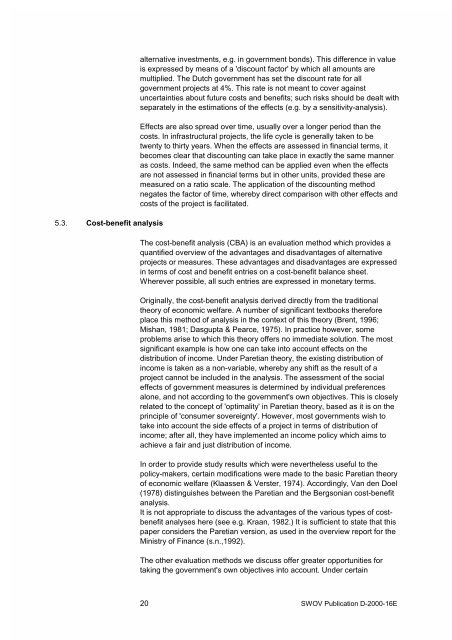Economic evaluation of road safety measures - Swov
Economic evaluation of road safety measures - Swov
Economic evaluation of road safety measures - Swov
You also want an ePaper? Increase the reach of your titles
YUMPU automatically turns print PDFs into web optimized ePapers that Google loves.
5.3. Cost-benefit analysis<br />
alternative investments, e.g. in government bonds). This difference in value<br />
is expressed by means <strong>of</strong> a 'discount factor' by which all amounts are<br />
multiplied. The Dutch government has set the discount rate for all<br />
government projects at 4%. This rate is not meant to cover against<br />
uncertainties about future costs and benefits; such risks should be dealt with<br />
separately in the estimations <strong>of</strong> the effects (e.g. by a sensitivity-analysis).<br />
Effects are also spread over time, usually over a longer period than the<br />
costs. In infrastructural projects, the life cycle is generally taken to be<br />
twenty to thirty years. When the effects are assessed in financial terms, it<br />
becomes clear that discounting can take place in exactly the same manner<br />
as costs. Indeed, the same method can be applied even when the effects<br />
are not assessed in financial terms but in other units, provided these are<br />
measured on a ratio scale. The application <strong>of</strong> the discounting method<br />
negates the factor <strong>of</strong> time, whereby direct comparison with other effects and<br />
costs <strong>of</strong> the project is facilitated.<br />
The cost-benefit analysis (CBA) is an <strong>evaluation</strong> method which provides a<br />
quantified overview <strong>of</strong> the advantages and disadvantages <strong>of</strong> alternative<br />
projects or <strong>measures</strong>. These advantages and disadvantages are expressed<br />
in terms <strong>of</strong> cost and benefit entries on a cost-benefit balance sheet.<br />
Wherever possible, all such entries are expressed in monetary terms.<br />
Originally, the cost-benefit analysis derived directly from the traditional<br />
theory <strong>of</strong> economic welfare. A number <strong>of</strong> significant textbooks therefore<br />
place this method <strong>of</strong> analysis in the context <strong>of</strong> this theory (Brent, 1996;<br />
Mishan, 1981; Dasgupta & Pearce, 1975). In practice however, some<br />
problems arise to which this theory <strong>of</strong>fers no immediate solution. The most<br />
significant example is how one can take into account effects on the<br />
distribution <strong>of</strong> income. Under Paretian theory, the existing distribution <strong>of</strong><br />
income is taken as a non-variable, whereby any shift as the result <strong>of</strong> a<br />
project cannot be included in the analysis. The assessment <strong>of</strong> the social<br />
effects <strong>of</strong> government <strong>measures</strong> is determined by individual preferences<br />
alone, and not according to the government's own objectives. This is closely<br />
related to the concept <strong>of</strong> 'optimality' in Paretian theory, based as it is on the<br />
principle <strong>of</strong> 'consumer sovereignty'. However, most governments wish to<br />
take into account the side effects <strong>of</strong> a project in terms <strong>of</strong> distribution <strong>of</strong><br />
income; after all, they have implemented an income policy which aims to<br />
achieve a fair and just distribution <strong>of</strong> income.<br />
In order to provide study results which were nevertheless useful to the<br />
policy-makers, certain modifications were made to the basic Paretian theory<br />
<strong>of</strong> economic welfare (Klaassen & Verster, 1974). Accordingly, Van den Doel<br />
(1978) distinguishes between the Paretian and the Bergsonian cost-benefit<br />
analysis.<br />
It is not appropriate to discuss the advantages <strong>of</strong> the various types <strong>of</strong> costbenefit<br />
analyses here (see e.g. Kraan, 1982.) It is sufficient to state that this<br />
paper considers the Paretian version, as used in the overview report for the<br />
Ministry <strong>of</strong> Finance (s.n.,1992).<br />
The other <strong>evaluation</strong> methods we discuss <strong>of</strong>fer greater opportunities for<br />
taking the government's own objectives into account. Under certain<br />
20 SWOV Publication D-2000-16E
















